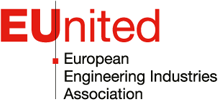You are here:
>
Municipal Equipment
>
Sweepers
Sweepers
This section includes manufacturers of surface cleaning machines for outdoor applications on public areas, roads, airports and industrial plants. EUnited Municipal Equipment represents more than 90 % of the European market.
These highly sophisticated cleaning machines range from truck-mounted sweepers, where the sweeping attachments are fixed or mounted on a standard vehicle-chassis, to self-propelled compact sweepers with a specially designed chassis, using integrated sweeping attachments and associated sweeping equipment.
PM 10 2,5 Test and Label for Sweepers
The Sweeper section developed the EUnited PM Test, the test procedure for measurement of the particulate matter, or fine dust, swirled up during sweeping. The tested sweepers are identifiable by the EUnited PM Test label, now widely adopted across Europe. The EUnited PM label is only available for EUnited members.
Fine particles have become a serious threat to the residents in many cities. Improving air quality has become a daily challenge for the local authorities and the use of sweepers to curb the amount of dust in public areas is common practice. When procuring their new sweepers, local authorities need a reliable standard in order to be able to compare the different types sweepers offered on the market, in terms of absorption of fine particles. Therefore, customers continually ask for the EUnited PM Test certificate - not only in Europe but also outside of Europe.
EUnited developed the PM test procedure in 2012 in cooperation with the most experienced testing institute in this field, Canadian PAMI. EUnited has charged SGS Institute Fresenius with the tests of different sweepers, which is one of the leading European test centres. This means that the neutrality of the test procedure is ensured. Only vehicles that have successfully passed the strict test will get the EUnited PM Test label.
The success of this EUnited PM Test initiative is based on the fact that all leading European manufacturers have agreed to carry out the same tests, to develop the procedures together with renowned scientists and to verify them by an experienced test house on behalf of EUnited Municipal Equipment. Thus, the EUnited PM Test label provides reliable information for the customer. All manufacturers have completed the EUnited PM Test with their machines and thus show their efforts to support the communities in their fight for clean air. Meanwhile, far more than 100 road sweeper types have been tested and are listed on the EUnited website. These sweepers can be recognised by their EUnited PM-test label.
With the publication of DIN EN 15429-3: 2015-05: Sweepers - Part 3: "Capacity of dust - testing and assessment" in May 2015, the EUnited PM Assessment became a recognized standard in Europe. The test method is thus becoming more common in Europe and beyond. However, sweepers will only receive the EUnited PM Test label if they meet the criteria laid down by EUnited.
Test Procedure
The test takes place in a controlled environment in order to avoid the adverse wind and weather exposure, thereby improving the reproducibility. During several test runs, the sweepers sweep a fixed test track, simulating a typical urban street. Defined sweepings are recorded under realistic working conditions, among other things along a curb. Dust reduction systems and water sprays are operated during the test under the settings specified by the manufacturer for the real operations.
For each passage, the absorbed amount of dirt is gathered and compared with the dose of sweeping material distributed to the test surface. This is how the sweeping performance of a sweeper is deduced.
Before, during and after the test runs, the fine dust concentration is measured and analysed in the enclosed test facility. The quantity of dust stirred up by the sweeping units can thus be determined, as well as that, which ended up in the container or in the filter of the sweeper.
The EUnited PM Test method can be used to test truck sweepers and compact sweepers, as well as mounted or towed sweepers.
Addition of PM 2,5 to Test Procedure
Through the European Air Quality Directive 2008/50/EC, cities and municipalities must ensure that emission limit values for fine particles are only exceeded on a limited number of days per year. This directive has required a limit value for the exposure concentration of PM10 since 2005. From the Beginning of 2015, member states have had to ensure that concentrations of PM2,5 in ambient air do not exceed a specific limit value. This limit will be further reduced in 2020. Therefore, more and more customers have asked for a validation of the PM2.5 absorption performance for sweepers in addition to PM10.
The European sweeper manufacturers in EUnited responded to this demand and together began to modify the test procedure and started to test the PM2.5 absorption performance of their sweepers with the target of testing all current sweeper models available on the European market by IFAT 2018.
Quicklinks
Videos
PM Test Promotional Video english
EUnited AISBL- European Engineering Industries Association,
Industrious Brussels EU District, Avenue des Arts 6-9, 1210 Brussels, Belgium, +32 490 57 57 65
Transparency Register number: 0289344948-82
Industrious Brussels EU District, Avenue des Arts 6-9, 1210 Brussels, Belgium, +32 490 57 57 65
Transparency Register number: 0289344948-82
© 2025 Eunited aisbl, Bruxelles
